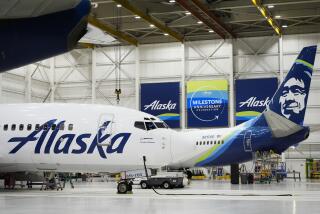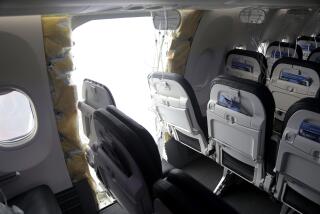After Germanwings crash, airlines revamp security, cockpit rules

<p>The copilot of a Germanwings flight that slammed into an Alpine mountainside intentionally sent the plane into its doomed descent, a French prosecutor said Thursday.</p>
The apparently deliberate act of a German pilot that caused the deaths of 150 people in France is leading to a broad reexamination of international airline security rules, which allowed the pilot to lock his more senior crew member out of the cockpit.
The cockpit door locking system, which was designed after the Sept. 11, 2001, attacks in the United States, was intended to prevent suicidal terrorists from seizing control of jetliners, but may have had the unintended consequence of allowing a single pilot to do the same.
“We are absolutely headed to a reevaluation of the system,” said Robert Ditchey, an aviation safety expert and former airline executive. “This is now an issue of how we keep mass murderers out of the cockpit.”
In response to the revelations about the crash of Germanwings Flight 9525, the German Aviation Assn. announced Thursday that all German carriers had agreed to new procedures, similar to those already in effect in the United States, that would require two people in a plane’s cockpit at all times. Several other carriers — including Air Canada, EasyJet, Norwegian Air Shuttle and Icelandair — announced similar changes in protocol.
French authorities said Andreas Lubitz, the German copilot of the flight from Barcelona, Spain, to Duesseldorf, Germany, on Tuesday kept the cockpit door locked after the pilot left, presumably to use the restroom. The pilot could be heard on the cockpit voice recorder pounding on the door after Lubitz purportedly set the aircraft on a deadly descent into the French Alps.
UPDATES: Latest developments on the crash
Investigators said Lubitz ignored radio calls and could be heard breathing normally as the aircraft went on a fairly steep descent from its 38,000-foot cruising altitude to about 5,000 feet, while passengers were screaming as they presumably saw the mountains looming and watched the pilot frantically trying to reenter the cockpit.
European authorities, along with the chief executive of Germanwings parent Lufthansa, said that nothing in Lubitz’s background could explain his behavior. The 27-year-old pilot had no known association with extremist or terrorist groups, German Interior Minister Thomas de Maiziere said.
German Chancellor Angela Merkel said the news had given the tragedy “a new, simply incomprehensible dimension.... Something like this goes beyond anything we can imagine.”
The dead included three Americans, the last of whom was identified by the State Department on Thursday as Robert Oliver. It provided no further details, but he was described in news reports as a Barcelona resident who worked for Spanish clothing company Desigual.
Half of the victims were German, including 16 students and two teachers from a high school in the northern town of Haltern Am See.
“I am asking myself, when is the nightmare going to end?” the town’s mayor, Bodo Klimpel, said Thursday at a news conference that was broadcast live in Germany. “It is even much, much worse than we had thought.”
In the aftermath of the Sept. 11 attacks, the aviation industry and U.S. law enforcement officials decided that cockpit doors would have to be hardened and locked securely to thwart a repeat. At the time, experts knew that the system would have to be tamper-proof or it would not ensure an end to hijackings.
“We discussed the unintended consequences of leaving a single pilot in the cockpit and we did an analysis of the greater risk, a suicidal pilot or a terrorist,” said Michael Barr, a U.S. air safety expert and former accident investigation instructor at USC. “The decision was a terrorist was the greater risk. We don’t want to reopen that door now.”
But the Germanwings incident was among more than half a dozen documented instances of a crew or crew member suspected of deliberate acts to crash a passenger plane.
In 1999, in one of the most notorious cases, an EgyptAir Boeing 767 jetliner plunged into the Atlantic Ocean shortly after takeoff from New York. U.S. investigators said the copilot had sent the jetliner on a dive after the pilot left the cockpit.
“It’s striking that in both instances it sounds like the pilot left the cabin,” said John Pistole, the agent who investigated the accident.
In another case, a Malaysia Airlines jetliner disappeared over the Indian Ocean in 2014 without a trace, and although the crew may have been incapacitated by a loss of cabin pressure, or some other cause, a deliberate act has not been ruled out. And a 1997 crash involving SilkAir in Indonesia was determined by U.S. investigators to be a deliberate act, although Indonesian officials sharply disputed the finding.
Notably, none of those cases involved U.S. pilots or airlines. Though not perfect, the U.S. has by wide agreement the world’s most experienced pilots and tightest safety regulations. Indeed, the Federal Aviation Administration on Thursday emphasized its two-in-the-cockpit rule.
“When one of the pilots exits the cockpit for any reason, another qualified crew member must lock the door and remain on the flight deck until the pilot returns to his or her station,” the FAA said in a written response to questions raised by the French disaster. “A qualified crew member could be a flight attendant or a relief pilot serving as part of the crew.”
Under U.S. security rules, there must be positive visual identification of the person seeking to reenter the cockpit, including verification that the person is not under duress, a procedure done by looking through a spyhole in the cockpit door, said Brian Schiff, an American Airlines captain. That verification is performed by the other crew member because the lone pilot is not allowed to move from the aircraft controls, he said.
Had a flight attendant been in the cockpit of the Germanwings plane, he or she might have been able to intervene or open the door.
Although the U.S. does not perform mandatory psychological tests on pilots, it has other advantages over foreign carriers, particularly in the experience of its flight crews. Lubitz had logged 630 flight hours, substantially below the U.S. minimum requirement of 1,500 hours for any copilot. In practice, the vast majority of U.S. copilots have far more than 1,500 hours, Ditchey, the safety expert, said.
And though the cockpit security doors may have assisted Lubitz in taking over the Germanwings flight, an opposite set of circumstances has also occurred. In an unusual March 2012 incident, a JetBlue copilot determined that his pilot was acting irrationally and managed to lock him out of the cockpit. While passengers subdued the captain, the copilot safely landed the jetliner in Amarillo, Texas.
The pilot, Clayton Osbon, was later found not guilty by reason of insanity of interfering with a flight crew.
Nonetheless, the Germanwings accident is likely to lead to a reconsideration of international rules and whether there could be a system to prevent a deranged pilot from crashing a plane. One possibility is a system that would allow ground controllers to seize the operation of an aircraft’s flight control computers if the crew veers from its planned flight path and refuses to explain its actions.
Such a system might have prevented the Germanwings accident, as well as the Sept. 11 attacks. Pilots and aviation experts say the system would be possible to implement with existing technology, though it could be costly to operate and introduce other issues, such as making a jetliner’s computer system vulnerable to a hacker.
“There will be a large examination of the procedures, but hopefully it will not compromise our existing security,” Schiff said. “We don’t have a problem with it in this country.... As long as the person in the cockpit does not want you to enter, you are not going to get in. I think it should stay that way.”
Times staff writer Vartabedian reported from Los Angeles and special correspondent Willsher from Paris. Times staff writers Matt Pearce and Hugo Martin in Los Angeles and special correspondent Jabeen Bhatti in Berlin contributed to this report.
UPDATES: Latest developments on the crash
How do you get through a locked cockpit door?
Traveling by plane: Trends show it is getting safer
More to Read
Start your day right
Sign up for Essential California for news, features and recommendations from the L.A. Times and beyond in your inbox six days a week.
You may occasionally receive promotional content from the Los Angeles Times.







